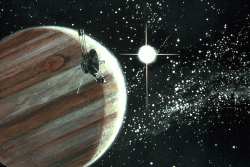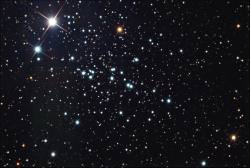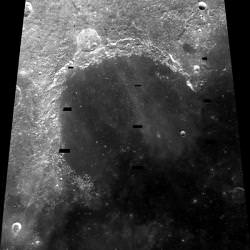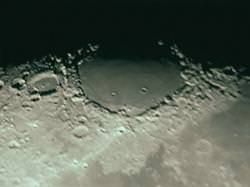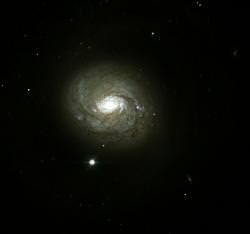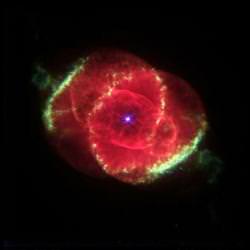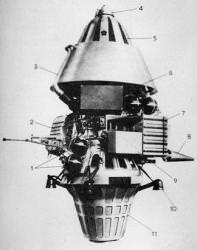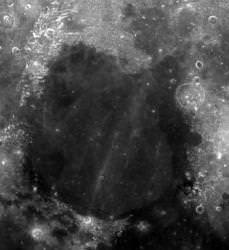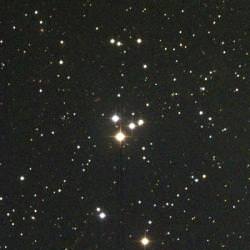Monday, December 3 – Today in 1971, the Soviet Mars 3 became the first spacecraft to make a soft landing on the red planet, and two years later on this same date the Pioneer 10 mission became the first spacecraft to fly by Jupiter. One year later on this same date? Pioneer 11 did the same thing!
Tonight let’s familiarize ourselves with the vague constellation of Fornax. Its three brightest stars form a shallow V just south of the Cetus/Eridanus border and span less than a handwidth of sky. Although it’s on the low side for northern observers, there is a wealth of sky objects in this area.
Try having a look at the easternmost star – 40-light-year distant Alpha. At magnitude 4, it is not easy, but what you’ll find there is quite beautiful. For binoculars, you’ll see a delightful cluster of stars around this long-term binary – but telescopes will enjoy it as a great golden double star! First measured by John Herschel in 1835, the distance between the pair has narrowed and widened over the last 172 years and it is suspected its orbital period may be 314 years. While the 7th magnitude secondary can be spotted with a small scope – watch out – because it may also be a variable which drops by as much as a full magnitude!
Tuesday, December 4 – Today in 1978, the Pioneer/Venus Orbiter became the first spacecraft to orbit Venus. And in 1996, the Mars Pathfinder mission was launched!
For larger telescopes, set sail for Beta Fornacis tonight and head 3 degrees southwest (RA 02 39 42.5 Dec -34 16 08.0) for a real curiosity – NGC 1049.
At magnitude 13, this globular cluster is a challenge for even large scopes – and with good reason. It isn’t in our galaxy. This globular cluster is a member of the Fornax Dwarf Galaxy – a one degree span that’s so large it was difficult to recognize as extra-galactic – or at least it was until the great Harlow Shapely figured it out!
NGC 1049 was first discovered and cataloged by John Herschel in 1847, only to be reclassified as “Hodge 3” in a 1961 study of the system’s five globular clusters by Paul Hodge. Since that time, yet another globular has been discovered! Good luck…
Wednesday, December 5 – Up before dawn? Then check out the skies because the stars of spring are returning! Let the waning Moon be your guide as it and Spica are only about two degrees apart!
How about something a little more suited to the mid-sized scope tonight? Set your sights on Alpha Fornacis and let’s head about 3 fingerwidths northeast (RA 03 33 14.65 Dec -25 52 18.0) for NGC 1360.
In a 6″ telescope, you’ll find the 11th magnitude central spectroscopic double star of this planetary nebula to be very easy – but be sure to avert because the nebula itself is very elongated. Like most of my favorite things, this planetary is a rule-breaker since it doesn’t have an obvious shell structure. But why? Rather than believe it is not a true planetary by nature, studies have shown that it could quite possibly be a very highly evolved one – an evolution which has allowed its gases to begin to mix with the interstellar medium.
Although faint and diffuse for northern observers, those in the south will recognize this as Bennett 15!
Thursday, December 6 – For northern observers clamoring for brighter stellar action, look no further tonight than the incredible “Double Cluster” about four fingerwidths southeast of Delta Cassiopeiae. At a dark sky site, this incredible pair is easily located visually and stunning in any size binoculars and telescopes.
As part of the constellation of Perseus, this double delight is around 7000 light-years away and less than 100 light-years separates the pair. While open clusters in this area are not really a rarity, what makes the “Double Cluster” so inviting is the large amount of bright stars within each of them.
Well known since the very beginnings of astronomy, take the time to have a close look at both Chi (NGC 884) and H Persei very carefully. Note how many colorful stars you see, and the vast array of double, multiple and variable systems!
Friday, December 7 – Today is the birthday of Gerard Kuiper. Born 1905, Kuiper was a Dutch-born American planetary scientist who discovered moons of both Uranus and Neptune. He was the first to know that Titan had an atmosphere, and he studied the origins of comets and the solar system.
Tonight let’s honor his achievements as we have a look at another bright open cluster known by many names: Herschel VII.32, Melotte 12, Collinder 23, and NGC 752. You’ll find it three fingerwidths south (RA 01 57.8 Dec +37 41) of Gamma Andromedae…
Under dark skies, this 5.7 magnitude cluster can just be spotted with the unaided eye, is revealed in the smallest of binoculars, and can be completely resolved with a telescope. Chances are it was first discovered by Hodierna over 350 years ago, but it was not cataloged until Sir William gave it a designation in 1786. But give credit where credit is due… For it was Caroline Herschel who observed it on September 28, 1783!
Containing literally scores of stars, galactic cluster NGC 752 could be well over a billion years old, strung out in chains and knots in an X pattern of a rich field. Take a close look at the southern edge for orange star 56: while it is a true binary star, the companion you see is merely optical. Enjoy this unsung symphony of stars tonight!
Saturday, December 8 – Today in history (1908) marks “first light” for the 60″ Hale Telescope at Mt. Wilson Observatory. Not only was it the largest telescope of the time, but it ended up being one of the most productive of all. Almost 100 years later, the 60″ Hale is still in service as a public outreach instrument. If we could use the 60″ tonight to study, where would we go? My choice would be the Fornax Galaxy Cluster!
Containing around 20 galaxies brighter than 13th magnitude in a one degree field, here is where a galaxy hunter’s paradise begins! About a degree and a half north of Tau Fornacis is the large, bright and round spiral NGC 1398. A little more than a degree west-northwest is the easy ring of the planetary nebula NGC 1360. Look for the concentrated core and dark dustlane of NGC 1371 a degree north-northeast – or the round NGC 1385 which accompanies it. Why not visit Bennett 10 or Caldwell 67 as we take a look at NGC 1097 about 6 degrees west-southwest of Alpha? This one is bright enough to be caught with binoculars!
Telescopes will love NGC 1365 at the heart of the cluster proper. This great barred spiral gives an awesome view in even the smallest of scopes. As you slide north, you will encounter a host of galaxies, NGCs 1386, 1389, 1404, 1387, 1399, 1379, 1374, 1381 and 1380. There are galaxies everywhere! But, if you lose track? Remember the brightest of these are two ellipticals – 1399 and 1404. Have fun!
Sunday, December 9 – Southern Hemisphere viewers, you’re in luck again on a New Moon night! This is the maximum of the Puppid-Velid meteor shower. With an average fall rate of about 10 per hour, this particular meteor shower could also be visible to those far enough south to see the constellation of Puppis. Very little is known about this shower except that the streams and radiants are very tightly bound together. Since studies of the Puppid-Velids are just beginning, why not take the opportunity to watch? Viewing will be possible all night long and although most of the meteors are faint, this one is known to produce an occasional fireball.
Since we’re favoring the south tonight, let’s set northern observers toward a galaxy cluster – Abell 347 – located almost directly between Gamma Andromedae and M34. Here you will find a grouping of at least a dozen galaxies that can be fitted into a wide field view. Let’s tour a few…
The brightest and largest is NGC 910, a round elliptical with a concentrated nucleus. To the northwest you can catch faint, edge-on NGC 898. NGC 912 is northeast of NGC 910, and you’ll find it quite faint and very small. NGC 911 to the north is slightly brighter, rounder, and has a substantial core region. NGC 909 further north is fainter, yet similar in appearance. Fainter yet is more northern NGC 906, which shows as nothing more than a round contrast change. Northeast is NGC 914, which appears almost as a stellar point with a very small haze around it. To the southeast is NGC 923 which is just barely visible with wide aversion as a round contrast change. Enjoy this Abell quest!

